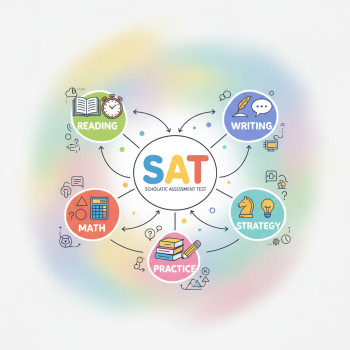AP vs SAT: A Gentle Intro for Late Bloomers
If you or your student are a late bloomer someone who discovers momentum a little later than classmates, or who thrives under focused, one-on-one attention you re not alone. Many high schoolers come into their own in junior or even senior year. The question that trips up families is practical and urgent: which path shows faster gains when time is short AP exams or the Digital SAT?
This article walks you through realistic timelines, the kinds of improvements you can expect, study strategies that actually work, and how a personalized approach (think tailored study plans, expert tutors, and AI-driven insights like those Sparkl offers) can transform a few months into measurable progress. No fluff just the kind of clear comparison that helps you plan.

Understanding the Two Tests: What They Really Measure
AP Exams Deep, Subject-Specific, and Course-Tied
Advanced Placement (AP) exams are subject exams tied to specific college-level courses. AP subjects range from Calculus and Biology to U.S. History and English Literature. The core idea: you demonstrate mastery of a defined body of knowledge and skills. Most AP exams are administered in May, and many schools now offer digital delivery for a number of subjects.
Strengths of APs for a late bloomer:
- Progress is tied to curriculum coverage if you can catch up on the course content, your score often follows.
- Improvement can be dramatic with focused content review and practice on the specific exam format (multiple choice, short answer, long-form essays or free-response questions).
- For motivated students who enjoy a subject, comprehension and retention grow quickly once foundational gaps are filled.
Digital SAT Broad, Strategy-Driven, and Time-Based
The Digital SAT is a general aptitude test assessing Evidence-Based Reading and Writing plus Math. It’s a single, standalone test used widely in college admissions. Unlike APs, which reward mastery of a subject, the SAT rewards both skill and strategy reading techniques, question interpretation, timing, and test-specific math skills.
Strengths of the SAT for late bloomers:
- Structured practice on question types and timing can yield relatively rapid score gains.
- Focused drills like reading passages, grammar rules, and targeted math problem types often lead to measurable improvement in weeks to months.
- Score gains are often predictable when a student has a clear baseline and follows a disciplined plan.
Which Shows Faster Turnaround for Late Bloomers?
Short answer: It depends. But here’s the practical way to think about it.
Baseline Matters
If a student already understands a subject’s key concepts (for an AP course) or has decent reading and math foundations (for the SAT), both tests can show rapid gains. If foundational gaps exist, AP improvement may require more time to learn the content deeply, while SAT gains can sometimes come faster through strategy and targeted skill-building.
Nature of the Work
AP improvement = content + application. You re building a body of knowledge and practicing applying it under exam conditions.
SAT improvement = strategy + skills + stamina. You can often see visible score jumps by learning how the test operates and practicing specific question types.
Typical Timelines Real-World Expectations
Below is a practical comparison of how fast a motivated late bloomer might see measurable change. These are general expectations based on common student experiences.
| Time Frame | AP Exams (subject-dependent) | Digital SAT |
|---|---|---|
| 4 8 weeks | Targeted gains in narrow areas (e.g., mastering free-response format, boosting grades on unit tests) if student has prior exposure; limited jump in overall exam score unless student already has strong content base. | Noticeable score increases from strategy improvement, timed practice, and targeted remediation especially in Reading/Writing. |
| 2 4 months | Substantial gains possible for students who use focused review resources (AP Classroom, past FRQs) and consistent practice; best for courses where conceptual gaps are bridgeable quickly (e.g., many social sciences). | Large, reliable score gains common with structured prep daily practice, practice tests, and targeted review of weak question types. |
| 5 8 months | Confidence and score improvements grow significantly for students who engage deeply with course material and practice; science and math APs may still require sustained effort depending on prior math background. | Approaching peak performance for many students consistency leads to mastering timing and stamina. |
Practical Considerations: Which One Should a Late Bloomer Choose First?
Deciding which exam to prioritize should be strategic, not emotional. Here are questions to guide the choice.
- What s the time window? (When are AP exams and SAT test dates relative to your timeline?)
- Where are the biggest gains likely? (If a student loves U.S. History and can close content gaps quickly, AP could be fastest. If the student reads well but struggles with timing, SAT might be fastest.)
- What do colleges and scholarships you re targeting value most? (Some colleges award credit for AP scores; some place more weight on an admission test.)
- Which test aligns with a student s learning style? (Content learning vs strategy drills.)
Example Scenarios
Here are three real-world style vignettes you might recognize:
- Sam, the Social Studies Late Bloomer: Sam always liked history but took the class casually. With focused review of key themes, guided practice on AP free-response questions, and a few months of targeted tutoring, Sam improved enough to earn a college credit-eligible score. The subject-based nature meant knowledge gaps were fixable quickly.
- Riya, the Strategic Test Taker: Strong reader, shaky on timing. With disciplined SAT practice timed sections, question-type drills, and targeted math review Riya boosted her score significantly in 8 12 weeks. SAT s strategy focus played to her strengths.
- Marcus, the Math-Gap Student: Marcus wanted Calculus AB but was behind on algebra fundamentals. Because building those fundamentals took longer, his AP turnaround was slower. He found that pairing concept review with a tutor who created a tailored plan (focusing on algebra and pre-calculus skills) accelerated his progress over several months.
How to Accelerate Turnaround: A Practical Roadmap
Whether you choose AP, SAT, or both, here’s a hands-on plan that late bloomers can follow to accelerate gains.
1. Diagnose Quickly
Spend a week taking diagnostic practice tests for AP (sample free-response questions and multiple-choice) and the Digital SAT (full timed section). The goal: find where the low-hanging fruit is specific topics or question types where small investments return the biggest score improvements.
2. Build a Focused Weekly Plan
Quality trumps quantity. A late bloomer s best friend is a plan that targets weaknesses, schedules frequent short practice sessions, and includes weekly full-length rehearsals for stamina.
- Example: 4 days/week of 60 90 minute focused sessions + 1 weekend full test or long practice section.
- Alternate content review with test-style practice to make learning stick.
3. Use Real Practice Materials
For AP: practice free-response questions from past years, use AP Classroom resources, and simulate timed conditions.
For the Digital SAT: use official practice tests, timed sections, and review mistakes thoroughly. Practice under test-like conditions to build timing and stress management.
4. Prioritize Feedback and Reflection
Practice without feedback is frictionless busywork. Have mistakes explained why an answer was wrong, how to spot traps, and which concept to revisit. This is where 1-on-1 tutoring can be transformational: a coach spots patterns of error and prescribes precise remedies.
5. Simulate Exam Conditions
A few full, timed practices are essential for both AP and SAT. They reveal stamina and timing issues and help acclimate a student to the testing environment.
Role of Personalized Tutoring: Why It Often Speeds Up Turnaround
Late bloomers benefit disproportionately from tutoring because tailored instruction replaces guesswork. Here s how personalized tutoring shortens the path to improvement:
- Targeted diagnostics identify the most impactful weaknesses quickly.
- Customized lesson plans prevent wasted time on already-mastered content.
- Expert tutors provide immediate, actionable feedback and accountability.
- Adaptive tools and AI-driven insights (where available) can highlight blind spots and suggest optimal practice sequences.
For families considering tutoring, note how a service like Sparkl blends expert tutors, 1-on-1 guidance, tailored study plans, and AI-driven insights to create a concentrated growth environment. That combination often results in faster, more sustained improvement especially when time is limited and every session must count.
Comparing Effort vs Reward: A Practical Table
Use this table to weigh time investment, likely gains for late bloomers, and strategic fit.
| Factor | AP Exams | Digital SAT |
|---|---|---|
| Time to See Noticeable Improvement | 2 4 months (if prior exposure exists); longer if concept gaps are large. | 4 12 weeks for many students with focused strategy and practice. |
| Best for | Students who can learn or already love a subject and can close content gaps. | Students who benefit from test strategy, timing practice, and targeted skill work. |
| How to Maximize Gains | Use AP Classroom resources, past free-response questions, and content-focused tutoring. | Use official Digital SAT practice, timed drills, and strategy-focused tutoring. |
| Typical Ceiling for Rapid Gains | Moderate to high if content gaps are easily addressed; science/math APs may need more time. | High many students see substantial score jumps with disciplined prep. |
Study Techniques That Work Fast for Late Bloomers
Active Recall and Spaced Practice
Instead of passive rereading, use flashcards (digital or paper), self-quizzing, and short daily reviews to lock in facts and concepts. Spaced practice ensures retention rather than last-minute cramming.
Targeted Error Logs
Maintain a notebook or digital log of every mistake. For each error, note why it happened, the correct reasoning, and one action to prevent it next time. Over weeks this log reveals patterns faster than random practice.
Mini-Mastery Approach
Break the course or test content into 10 15 bite-sized units. Master one unit per week; the cumulative effect compounds quickly.
Timed Micro-Sessions
For the SAT, practice short timed sets of 10 15 questions to build focus and speed. For AP FRQs, practice writing quick outlines and timed paragraphs to build clarity under time pressure.
How Parents Can Support Without Taking Over
- Set realistic goals and celebrate small wins a 20-point SAT increase or a better AP practice essay are meaningful milestones.
- Create a distraction-free study routine and protect study time.
- Help find the right tutor or prep resource and check in weekly on progress, not just hours logged.
- Encourage balance sleep, nutrition, and short breaks matter for learning efficiency.
Final Checklist: Decide, Plan, Execute
Use this checklist to move from decision to action in a week.
- Take diagnostics for AP (past FRQs, multiple-choice samples) and a Digital SAT practice section.
- Meet a tutor or academic coach for a 1-hour consult to build a 90-day plan.
- Schedule weekly practice blocks and 2 3 timed full practices before the exam.
- Track errors, adapt the plan, and increase practice intensity two weeks before the test.
Parting Thoughts: Growth Is Possible and Faster Than You Think
Late bloomers often carry an advantage: they arrive with clarity about their goals, motivation to grow quickly, and the maturity to follow a focused plan. Whether AP exams or the Digital SAT is the faster route depends on the student’s baseline, the specific subject, and how quickly gaps can be filled. For many students, the SAT s strategy-heavy nature yields quick wins; for others, an AP subject that resonates can be the fastest path to a meaningful score improvement.
If you want to compress the timeline, personalized support is the multiplier. One-on-one tutoring that diagnoses weaknesses, prescribes exact practice, and provides timely feedback paired with adaptive tools and AI-driven insights turns months of uncertain effort into weeks of targeted, high-impact work. That s precisely why many families choose tailored programs like Sparkl for their late-blooming students: focused study plans, expert tutors, and technology that helps prioritize what truly moves the score needle.
Ready to Decide?
Start with a diagnostic this week. Pick one target AP or SAT build a compact plan, and iterate based on results. Late bloomers don t need more time; they need a better plan. With the right approach, the turnaround is faster than it feels, and the momentum you build now will carry into college and beyond.

Good luck. You re farther along than you think one diagnosis, one targeted week of work, and one great tutor session can change the story.


















No Comments
Leave a comment Cancel